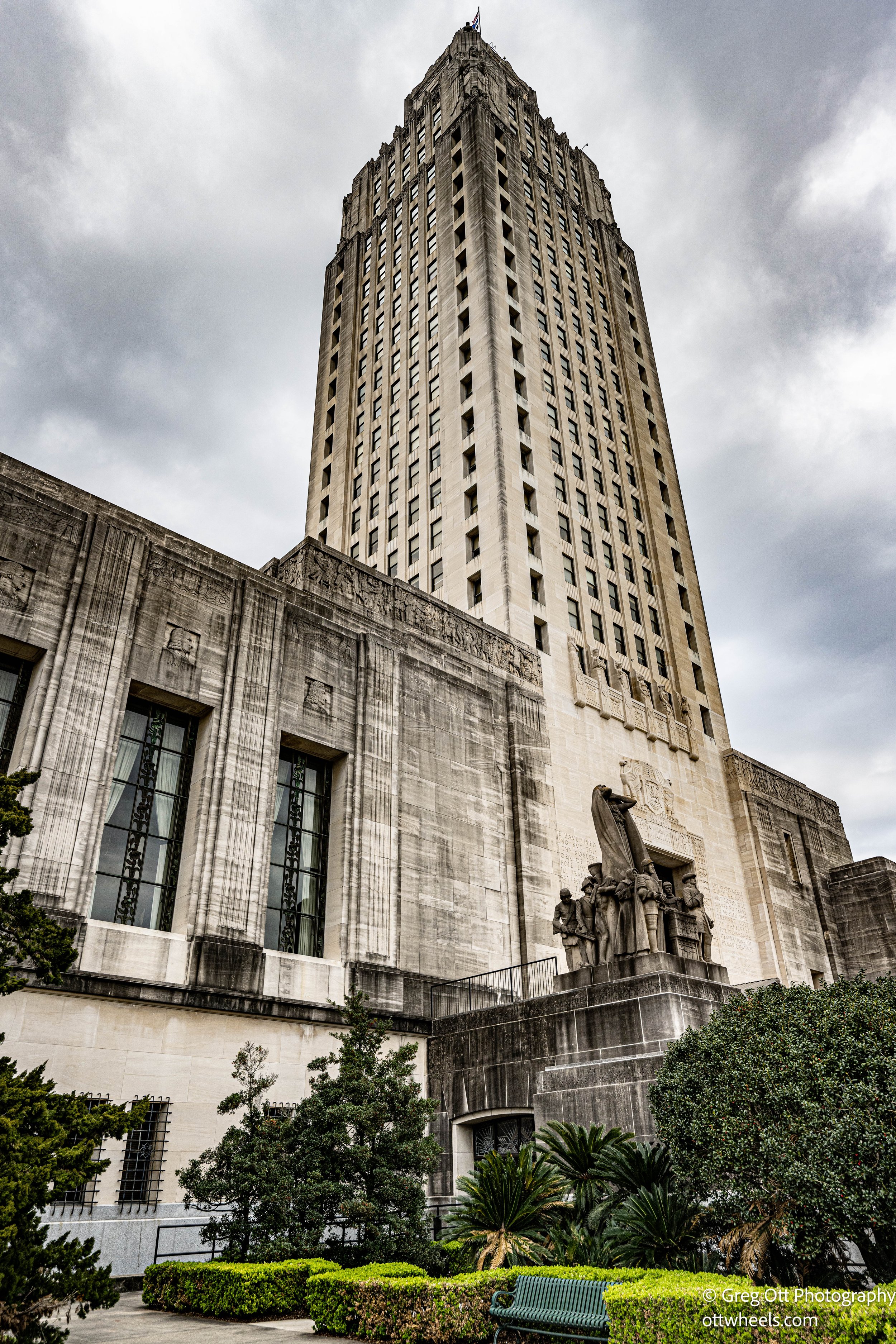Baton Rouge, Louisiana: Tale Of Two Capitols
I spent about seven hours in Baton Rouge. My intention was to visit the State Capital and as with previous states, to walk the grounds of the capital.
Baton Rouge, the capital city of Louisiana, is home to two iconic capital buildings. The first is the Old State Capitol, which stands as a historic landmark and museum, and the second is the current Louisiana State Capitol, a towering skyscraper that dominates the skyline of Baton Rouge. The tale of these two capital buildings is one of history, politics, and power, which was heavily influenced by the infamous Louisiana governor, Huey Long.
I parked the car about a half a mile away and walked to the old capitol building. There is some interesting history and architecture to be seen along the way.




My first stop was the Old State Capitol which looked more like a castle than the typical government center with a rotonda. I saw that the building was open and I was greeted by a young student. He explained where things were in the building and that there was a 15 minute movie, “The Ghost of the Castle“. The movie was $2, and provides a 4-D immersive experience narrated by the ghost of Sarah Morgan. It was a very entertaining and informative presentation.
Sarah Morgan
Sarah Morgan was a Louisiana-born writer and diarist who lived during the Civil War era. She was born in Baton Rouge in 1842 and grew up in a wealthy family. During the Civil War, she kept a detailed diary that documented her experiences and those of her family and friends. Her diary, published as "The Civil War Diary of Sarah Morgan," has become an important historical record of the Civil War in Louisiana.
In her diary, Sarah Morgan often wrote about her love for the Louisiana State Capitol building in Baton Rouge. She described the building as "majestic" and "lovely," and she often marveled at its beauty and grandeur. She also wrote about attending social events and political rallies at the Capitol, where she admired the architecture and the sense of power and importance that the building conveyed. Morgan's love for the Louisiana State Capitol is evident throughout her diary, and her descriptions of the building offer a fascinating glimpse into the political and cultural climate of Baton Rouge during the Civil War era.
One of the the many exhibits in the historic section of the capital covers her writtings.
The Old State Capitol
The Old State Capitol is a Gothic architectural masterpiece that was completed in 1852. It served as the Louisiana State Capitol for over 70 years until the construction of the new State Capitol in 1932. The building is steeped in history and was witness to many significant events, including the Louisiana Secession Convention and the impeachment of Governor Henry Warmoth. The building also witnessed the burning of the city by Union forces during the Civil War.
However, the Old State Capitol's most notable moment came in 1926 when Governor Huey P. Long was impeached by the Louisiana House of Representatives. Long was accused of embezzlement and other crimes but was ultimately acquitted by the Louisiana Senate. The impeachment trial took place in the Senate Chamber of the Old State Capitol, which was also used as the courtroom.





Huey Long
Huey Pierce Long, also known as "The Kingfish," was a colorful and controversial political figure who served as the Governor of Louisiana from 1928 to 1932. Long was born on August 30, 1893, in Winnfield, Louisiana, and grew up in a poor farming family.
After studying law and working as a lawyer and railroad commissioner, Long entered politics, championing the cause of poor farmers and challenging the power of the state's wealthy elite. He was a charismatic speaker and master of political maneuvering, and he implemented a series of populist reforms as governor, including building roads, schools, and hospitals.
Long's popularity continued to grow, and he was elected to the U.S. Senate in 1930. However, his ambitious plans to redistribute wealth and power brought him into conflict with other politicians, and his increasing authoritarianism and corruption drew criticism and opposition.
It should also be noted that Huey Long was considered a serious presidential candidate before being assasinated.


Walk To New Capitol Building
I was looking for something to eat as I walked to the new capitol building and found Schlittz and Giggles downtown. I ordered a slice of pepperoni pizza. The area looked like something out of a 1950s town center. Across the street was a large neon Coca-Cola sign.


As I walked, I notice a guy with a video camera, setting up. His name was Byron from the local TV station (WAFB Channel 9). There was an interview going to happen regarding the Kress building across the street. He couldn’t tell me much about the building.



When I got back I looked it up. It was the S.H. Kress Department Store, which was the site of a landmark sit in at the lunch counter by students to protest segregation in Louisiana. The building has been saved from demolition and was listed on the National Register of Historic Places in 2005.
The New Capitol Building
Despite being acquitted, Long was deeply resentful of the impeachment proceedings and vowed to get his revenge. In 1929, Long was elected to the United States Senate, and he began planning his revenge. He set his sights on moving the Louisiana State Capitol from Baton Rouge to a new location in his hometown of Shreveport. Long claimed that Baton Rouge was susceptible to flooding and that the state needed a new capital in a more central location.
Long's plan to move the capital faced fierce opposition from Baton Rouge's residents and politicians, who feared the loss of their city's status and economic benefits. However, Long's immense political power and influence ensured that the proposal was taken seriously. The plan ultimately failed due to logistical and financial difficulties.
Long, undeterred, then set his sights on a new plan. He decided to build a new State Capitol in Baton Rouge, which would be the tallest building in Louisiana and serve as a monument to his power and influence. Long's plan was to use his political influence to secure funding for the new building and oversee its construction.









Construction on the Louisiana State Capitol began in 1930 and was completed in 1932. The building's construction was not without controversy, as Long used unscrupulous means to secure funding and control the construction process. The result was a magnificent skyscraper that still stands today as a testament to Long's influence and power.
However, Long's revenge was not yet complete. In 1935, he ordered the destruction of the Louisiana Governor's Mansion, which had been built in 1887. The mansion had served as the residence of Louisiana's governors for almost 50 years, and its destruction was seen as an act of vengeance against Long's political enemies. The mansion's ruins still stand today as a reminder of Long's power and influence.
Long's life was cut short when he was assassinated in 1935, but his legacy as a populist champion of the people continues to resonate in Louisiana and beyond.
The New Capitol Building closes at 4:30. I had nine minutes to walk around the first floor. I was out of the building at 4:30 and everyone shutdown their stations.
Pink
I pulled up google maps and setup the route back to my car. The route took me in to the Spanish district and I walked by a house heavily decorated in pink. I took a photograph of the house and two dogs came out to greet me. Soon, a woman, Jamie, came out of the house. I asked her about the pink decorations and she explained that Marti Gras ended yesterday and that the Spanish district had a big street party and people decorated their homes.
Jamie was extremely friendly and invited me up to the porch. Her husband was busy working on a project in the other unit next door. She told me about their other properties in Louisiana. They also have an RV that they like to take on the road.
Before leaving, she had me sign the guest book. I took a photo of a pink flamingo with a bowtie and later learned it is an icon of the Spanish Town Mardi Gras celebration in Baton Rouge.




As I walked back to the car I noticed a lot of murals on buildings and stopped to capture some of them.




I was driving out of town and saw the New Governor’s Mansion and had to stop for a photo.
I was on my way to the New Orleans KOA. They would be closing at 7:00. I arrived about ten minutes before they closed. The staff was extremely friendly and they gave me some tips of things to see. The woman who took my reservation was an avid cyclist. She told me she owned nine bicycles. She told me where the bike paths were. I realized that it was 7:15 pm and apologized for keeping them after closing time.
I found my way to the camp site, setup, made dinner, cleaned up and fell asleep. Unfortunetely, I missed Mardi Gras, which ended yesterday.

